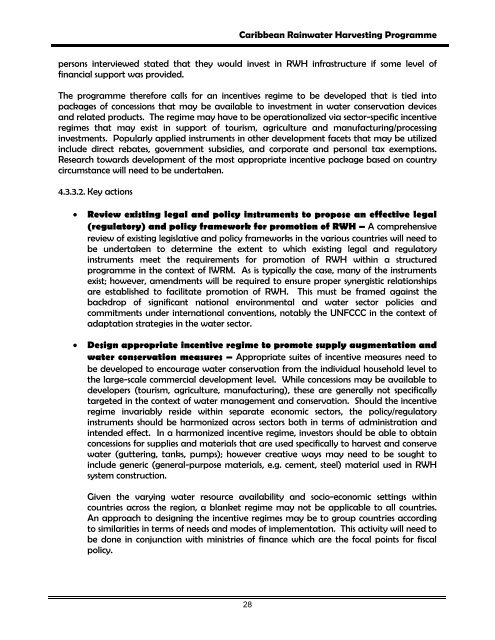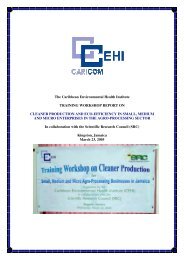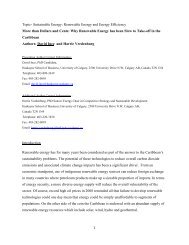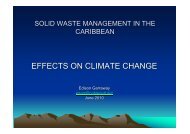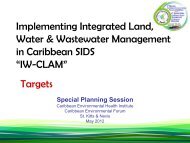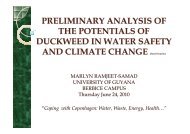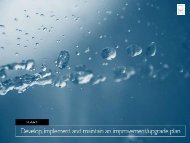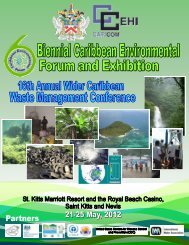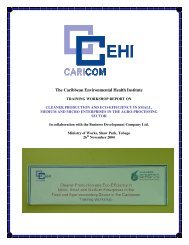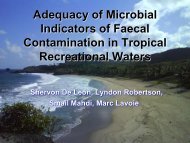A programme for Promoting Rainwater Harvesting in the Caribbean
A programme for Promoting Rainwater Harvesting in the Caribbean
A programme for Promoting Rainwater Harvesting in the Caribbean
Create successful ePaper yourself
Turn your PDF publications into a flip-book with our unique Google optimized e-Paper software.
<strong>Caribbean</strong> <strong>Ra<strong>in</strong>water</strong> <strong>Harvest<strong>in</strong>g</strong> Programmepersons <strong>in</strong>terviewed stated that <strong>the</strong>y would <strong>in</strong>vest <strong>in</strong> RWH <strong>in</strong>frastructure if some level off<strong>in</strong>ancial support was provided.The <strong>programme</strong> <strong>the</strong>re<strong>for</strong>e calls <strong>for</strong> an <strong>in</strong>centives regime to be developed that is tied <strong>in</strong>topackages of concessions that may be available to <strong>in</strong>vestment <strong>in</strong> water conservation devicesand related products. The regime may have to be operationalized via sector-specific <strong>in</strong>centiveregimes that may exist <strong>in</strong> support of tourism, agriculture and manufactur<strong>in</strong>g/process<strong>in</strong>g<strong>in</strong>vestments. Popularly applied <strong>in</strong>struments <strong>in</strong> o<strong>the</strong>r development facets that may be utilized<strong>in</strong>clude direct rebates, government subsidies, and corporate and personal tax exemptions.Research towards development of <strong>the</strong> most appropriate <strong>in</strong>centive package based on countrycircumstance will need to be undertaken.4.3.3.2. Key actions• Review exist<strong>in</strong>g legal and policy <strong>in</strong>struments to propose an effective legal(regulatory) and policy framework <strong>for</strong> promotion of RWH – A comprehensivereview of exist<strong>in</strong>g legislative and policy frameworks <strong>in</strong> <strong>the</strong> various countries will need tobe undertaken to determ<strong>in</strong>e <strong>the</strong> extent to which exist<strong>in</strong>g legal and regulatory<strong>in</strong>struments meet <strong>the</strong> requirements <strong>for</strong> promotion of RWH with<strong>in</strong> a structured<strong>programme</strong> <strong>in</strong> <strong>the</strong> context of IWRM. As is typically <strong>the</strong> case, many of <strong>the</strong> <strong>in</strong>strumentsexist; however, amendments will be required to ensure proper synergistic relationshipsare established to facilitate promotion of RWH. This must be framed aga<strong>in</strong>st <strong>the</strong>backdrop of significant national environmental and water sector policies andcommitments under <strong>in</strong>ternational conventions, notably <strong>the</strong> UNFCCC <strong>in</strong> <strong>the</strong> context ofadaptation strategies <strong>in</strong> <strong>the</strong> water sector.• Design appropriate <strong>in</strong>centive regime to promote supply augmentation andwater conservation measures – Appropriate suites of <strong>in</strong>centive measures need tobe developed to encourage water conservation from <strong>the</strong> <strong>in</strong>dividual household level to<strong>the</strong> large-scale commercial development level. While concessions may be available todevelopers (tourism, agriculture, manufactur<strong>in</strong>g), <strong>the</strong>se are generally not specificallytargeted <strong>in</strong> <strong>the</strong> context of water management and conservation. Should <strong>the</strong> <strong>in</strong>centiveregime <strong>in</strong>variably reside with<strong>in</strong> separate economic sectors, <strong>the</strong> policy/regulatory<strong>in</strong>struments should be harmonized across sectors both <strong>in</strong> terms of adm<strong>in</strong>istration and<strong>in</strong>tended effect. In a harmonized <strong>in</strong>centive regime, <strong>in</strong>vestors should be able to obta<strong>in</strong>concessions <strong>for</strong> supplies and materials that are used specifically to harvest and conservewater (gutter<strong>in</strong>g, tanks, pumps); however creative ways may need to be sought to<strong>in</strong>clude generic (general-purpose materials, e.g. cement, steel) material used <strong>in</strong> RWHsystem construction.Given <strong>the</strong> vary<strong>in</strong>g water resource availability and socio-economic sett<strong>in</strong>gs with<strong>in</strong>countries across <strong>the</strong> region, a blanket regime may not be applicable to all countries.An approach to design<strong>in</strong>g <strong>the</strong> <strong>in</strong>centive regimes may be to group countries accord<strong>in</strong>gto similarities <strong>in</strong> terms of needs and modes of implementation. This activity will need tobe done <strong>in</strong> conjunction with m<strong>in</strong>istries of f<strong>in</strong>ance which are <strong>the</strong> focal po<strong>in</strong>ts <strong>for</strong> fiscalpolicy.28


